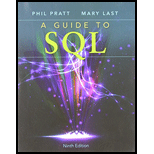
Functional dependencies:
Functional dependency is a term in the relational
- DEPARTMENT_NUM à DEPARTMENT_NAME
- ADVISOR_NUM à ADVISOR_LAST_NAME, ADVISOR_FIRST_NAME, DEPARTMENT_NUM
- COURSE_CODE à DESCRIPTION
- STUDENT_NUM à STUDENT_LAST_NAME, STUDENT_FIRST_NAME, ADVISOR_NUM
- STUDENT_NUM, COURSE_CODE à GRADE
Relations:
The term relation refers to the relationship between the data represented in a row-column format. The relative relations for the given database table is as follows:
- DEPARTMENT (DEPARTMENT_NUM, DEPARTMENT_NAME)
- ADVISOR (ADVISOR_NUM, ADVISOR_LAST_NAME, ADVISOR_FIRST_NAME, DEPARTMENT_NUM)
- COURSE (COURSE_CODE, DESCRIPTION)
- STUDENT (STUDENT_NUM, STUDENT_LAST_NAME, STUDENT_FIRST_NAME, ADVISOR_NUM)
For the database, a new relation is defined as it is mentioned that an advisor can advise any number of students but each student has only one advisor. Therefore, it can be defined as follows:
STUDENT_COURSE (STUDENT_NUM, COURSE_CODE, GRADE)
The above relations are defined for the condition when an advisor can advise any number of students but the student can have only one advisor. Therefore, it clearly represents that the relation between the advisor and the student is many-to-one relation.
Want to see the full answer?
Check out a sample textbook solution
Chapter 2 Solutions
A Guide to SQL
- Please original work What is the importance of understanding both DSS models and OLAP in modern business analytics. Reflect on how the combination of these tools can enhance decision-making processes in organizations. Please cite in text references and add weblinksarrow_forwardPlease original work Talk about the role of Decision Support Systems (DSS) in business analytics. What are the major types of models used in DSS: optimization, simulation, forecasting, heuristic, and descriptive models. Talk about the relevance of these models in supporting business decisions. Please cite in text references and add weblinksarrow_forwardPlease original work What are two DSS models (e.g., optimization and forecasting). What are each model’s purpose, advantages, and limitations in the context of business analytics. Talk about some examples of how each model can be applied in real-world business scenarios, particularly in operations, marketing, or finance. Please cite in text references and add weblinksarrow_forward
- Please original work What is Online Analytical Processing (OLAP) and describe its role in DSS. Talk about how OLAP supports multidimensional analysis and decision-making in businesses. Compare how OLAP differs from traditional DSS models in terms of data processing and output. Please cite in text references and weblinksarrow_forwardPlease original work Describe the key steps involved in the modeling process: problem definition, data collection, model formulation, validation, implementation, and refinement. Talk about why each step is critical to ensuring the accuracy and reliability of the model. What are some real-world business example of a problem, and describe how the modeling process could be applied to address it using DSS. Please cite in text references and add weblinksarrow_forwardYou will be using the "usdata" package's "county" data # for this assignment. # You will need to run:# install.packages("usdata")# once to install this library - do not include the# install.packages command in your submission# as it can cause gradescope to fail ## ## ## ## ## DO NOT MODIFY BELOW ## ## ## ## ## library(usdata)county<-as.data.frame(county)county<-county[,1:14]county<-county[rowSums(is.na(county))==0,]# The set.seed command will ensure your results are consistent# each time you run the "source" commandset.seed(311)## ## ## ## ## DO NOT MODIFY ABOVE ## ## ## ## ## # Treating the "county" dataset as the population of US counties# create the dataframe "my.SRS" that represents a simple# random sample of n=250 individual counties from all counties in the US. my.SRS <- NA # Treating the "county" dataset as the population of US counties# create the dataframe "my.Stratified" that represents a stratified# sample of individual counties from all counties in…arrow_forward
- = 3. [40 pts] In the following C program ex2_2.c, we first declare and initialize an array int arr[3] {1,3,5}. Please convert the C code in main function into Assembly language. We provide the array initialization code in ex2_2_assembly.s for reference. Please complete and submit your code. ex2_2.c: #include int main() { } int arr[3] ={1,3,5}; //declare and initialize the array arr int x11 = arr[0]; int x12 = arr[1]; int x13 =x11x12; int x14 = x13 << x11; // "<<" is left shift operator arr[1] arr [2] = x13; = x14; return 0; //no need to convert this line into assembly languagearrow_forwardPlease answer JAVA OOP problem.arrow_forwardAnswer these two JAVA OOP questions.arrow_forward
 A Guide to SQLComputer ScienceISBN:9781111527273Author:Philip J. PrattPublisher:Course Technology PtrCOMPREHENSIVE MICROSOFT OFFICE 365 EXCEComputer ScienceISBN:9780357392676Author:FREUND, StevenPublisher:CENGAGE L
A Guide to SQLComputer ScienceISBN:9781111527273Author:Philip J. PrattPublisher:Course Technology PtrCOMPREHENSIVE MICROSOFT OFFICE 365 EXCEComputer ScienceISBN:9780357392676Author:FREUND, StevenPublisher:CENGAGE L- Np Ms Office 365/Excel 2016 I NtermedComputer ScienceISBN:9781337508841Author:CareyPublisher:Cengage
 C++ for Engineers and ScientistsComputer ScienceISBN:9781133187844Author:Bronson, Gary J.Publisher:Course Technology Ptr
C++ for Engineers and ScientistsComputer ScienceISBN:9781133187844Author:Bronson, Gary J.Publisher:Course Technology Ptr





